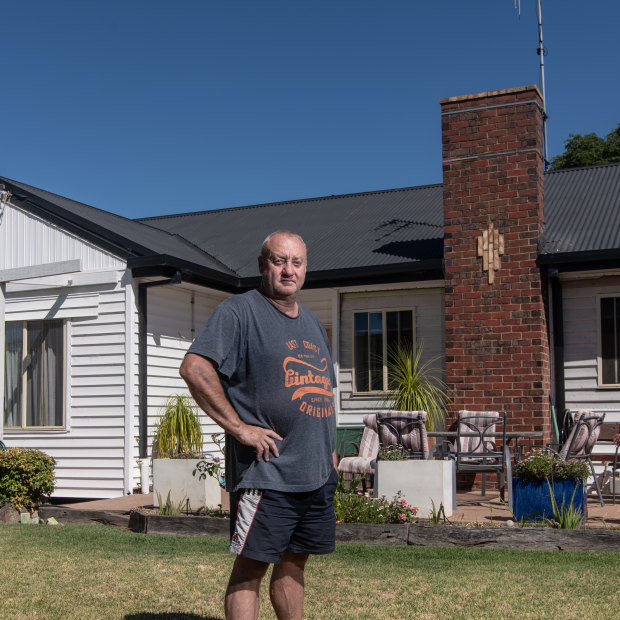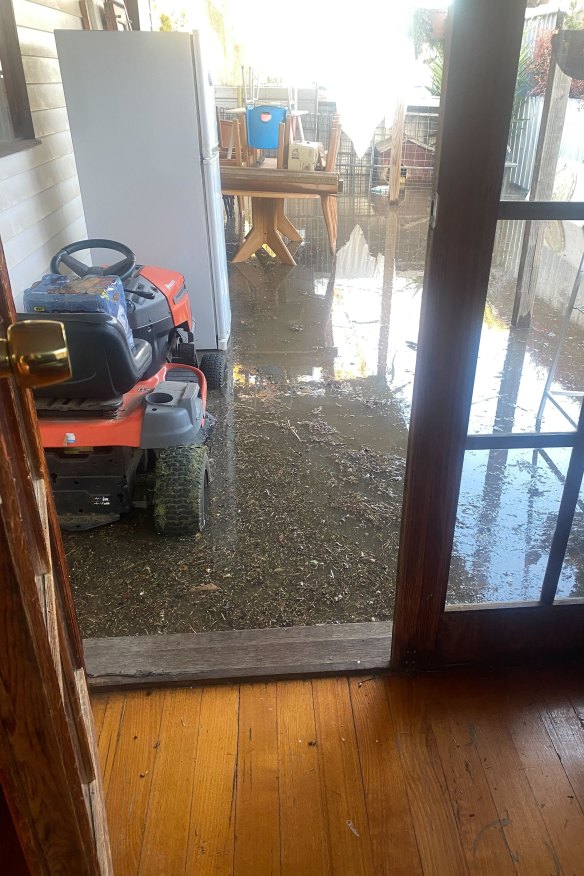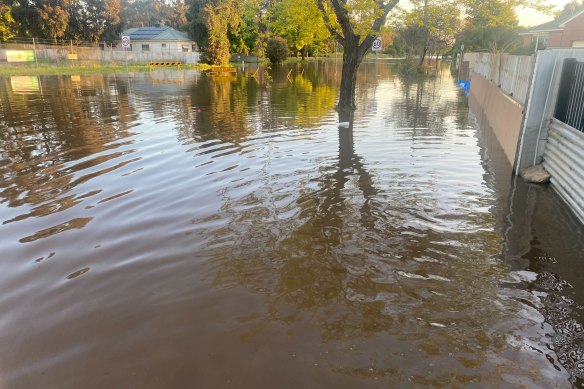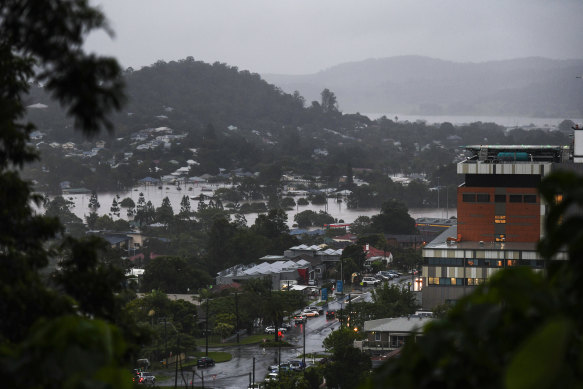
Almost 18 months after his home was flooded, Rick Maloney is still battling his insurance company.Credit: Justin McManus
There was nothing more Rick Maloney could have done when the floods hit his home town of Mooroopna, in Victoria’s north, in October 2022.
He had sandbagged the front perimeter of his property, erected a sheet of corrugated iron to protect the yard from harsh waves, and then sat at his dining table watching the putrid waters slowly rise around him.
“I had a kitchen table outside … and thought I might go put that table up on a brick just to get it out of the water, and the brick is four inches,” Maloney says.
“Within an hour, I had to go put another brick under it, within another hour, another brick, and then within another hour I had to put a fourth brick under it. It had come up that quick … But there’s nothing you can do. We just had to sit back and watch it all unfold.”
The real battle would begin months later when Maloney lodged a claim with his insurer, AAMI, to repair the damage to his home.
The insurance company refused his claim, alleging the damages were the result of a large gum tree in the backyard, while the grandfather-of-two has insisted the stumps shifted and the walls cracked after the floods.
Almost 18 months after the natural disaster that wreaked havoc across Victoria, and pushed up Maloney’s insurance premiums by 80 per cent, he is still fighting the insurance company.
“Can you imagine being one of the people in Rochester, being 80 or 90 years old, and going through all of this,” he says.
“This has occupied quite a lot of time, just to prove what they’re saying is a load of bullshit. My mental health doesn’t handle it very well.”

Rick Maloney’s home flooded in October 2022. Credit: Rick Maloney
Maloney is far from alone in his battle.
Between February 1, 2022 and September 30, 2023, the Australian Financial Complaints Authority received more than 45,000 general insurance complaints, a 39 per cent increase compared to the same period a year earlier.
Maloney has lodged a complaint with AFCA, which preliminarily ruled in favour of the insurer because he had not provided the authority with an independent report. Maloney says he is now in the process of commissioning the report to present to AFCA.
A spokesman for AAMI’s owner, Suncorp, said: “This matter was previously before the Australian Financial Complaints Authority to complete a fair and independent review. While we sympathise with Mr Maloney’s situation, we stand by our expert reports that comprehensively support our decision on this claim.”

Mooroopna streets under water. Credit: Rick Maloney
The 2022 east coast flooding disaster was the second-largest insured event in the world that year, and resulted in more than 240,000 claims with a total value of $6 billion.
The scale of the disaster caught the industry by surprise, and the timing of the floods, on the back of the pandemic when labour and supplies were in short supply, compounded the problem.
‘Insurers’ … starting position is they’re looking to decline a claim, rather than looking for ways to accept it.’
Consumer Action Law Centre managing lawyer Philippa Heir
Consumer Action Law Centre managing lawyer Philippa Heir says it is also taking a lot longer for insurance issues to be resolved, making it more stressful for people who have lived through a natural calamity.
“There seems to be a cultural problem with insurers,” she says. “Their starting position is they’re looking to decline a claim, rather than looking for ways to accept it.”
Under pressure
As climate change increases the severity and frequency of natural disasters, the horror floods of 2022 and the intense bushfires of 2019, dubbed once-in-a-century events, will likely become more regular occurrences.
It is therefore imperative for governments, insurance companies and communities to act now to mitigate the risks, says Antonia Settle, a McKenzie postdoctoral fellow at the Melbourne Institute of Applied Economic and Social Research.
“Insurance isn’t working well in this kind of [flooding] disaster, and with climate change, this is a growing problem,” says Settle. “Before 2012, flood coverage didn’t really exist as a mainstream insurance product. Ten to 12 years later, we have flood cover, but it’s becoming so unaffordable and so problematic, it doesn’t really work.”
‘Most of the people in parliament are probably insured and don’t realise there’s an issue.’
Antonia Settle from the Melbourne Institute of Applied Economic and Social Research
The insurance industry knows it is under pressure.
Consumer groups are closely monitoring the sector, which is not only squeezing households in a cost-of-living crisis as insurance premiums rise at double the rate of inflation, but because of the way customers are dealt with after a disaster.
Politicians are also scrutinising the industry after the Albanese government last year launched a parliamentary inquiry into the fallout of the 2022 floods, to examine insurance coverage and the underlying risks. The probe has so far received 45 submissions and held nine public hearings.
The corporate regulator has also identified insurance claims handling as a top enforcement priority for 2024. Australian Securities and Investments Commissioner Alan Kirkland fired off a missive to insurers earlier this month, warning them to lift their games.
“There’s been a policy vacuum because no one’s known this is a problem,” Settle says. “Most of the people in parliament are probably insured and don’t realise there’s an issue. Financial counsellors, in the wake of disasters, report huge rates of underinsurance, but there’s been no data. It’s a difficult problem to resolve, but we don’t have state intervention the way other countries have, so it’s left to the market.”
Insurers are legally required to act efficiently, honestly and fairly when handling claims, but victims of natural disasters often speak of a harrowing, fraught and drawn-out process that adds to their trauma.

Lismore was devastated by floods in early 2022. Credit: Elise Derwin
There is no standard definition of a “storm” across the industry, for example, meaning customers and the big insurers can find themselves quibbling over what constitutes a major tempest. If there was a storm after a flood event, was the damage to the home caused by the storm that has no legal definition, or the flood, which is standardised across the industry?
Then there’s the issue of “fair wear and tear”. Did the back fence collapse during the floods because it had not been appropriately maintained over the years, or was its destruction solely caused by the severe weather?
One submission to the inquiry described the market as a “confusopoly”, with consumers facing “an almost soul-crushing amount” of information and choice about the insurance product.
It is these often seemingly ridiculous and petty issues that lead to homeowners who have lost their houses in a natural disaster fighting insurance companies for months and sometimes years.
“We’re experiencing more frequent and severe natural hazard events, which is making insurance costly and exposing gaps in insurer capacity to process claims,” says Labor MP Daniel Mulino, the chair of the parliamentary inquiry. “We expect insurers to improve their communication with consumers and do the right thing by their customers by addressing any gaps in their processes.”
Insurance companies’ revenues and profit
- QBE’s revenue increased 10 per cent to $20.8 billion in 2023, while its profit jumped 118 per cent to $1.3 billion
- Suncorp’s revenue increased 12 per cent to $6.7 billion, while its profit rose 6 per cent to $596 million in 2023
- IAG’s revenue jumped 15.5 per cent to $8.68 billion, while its profit slumped 16.8 per cent to $407 million in 2023
- RACQ’s revenue in 2022-23 climbed 17 per cent to $2.4 billion, while it recorded a $7.4 million profit - a massive turnaround from the $245 million loss in the same period a year earlier
‘Flood cover is just not working’
ASIC examined the issues that frequently cropped up from households whose homes had been affected by natural disasters between early 2022 and late last year, and identified five key problems: poor communication, delays in processing claims, poor project management, poor complaints handling, poor identification of vulnerable customers, and inadequate staffing.
“The evidence suggests these are long-term issues,” ASIC commissioner Kirkland says.
“Insurers haven’t had enough staff to deal with increasing number of claims that are going to come from severe weather events. We’re already seeing more frequent severe weather events and more of those events will be quite extreme, so insurers can’t plan for the level of claims they might have expected five or 10 years ago. They need to be anticipating higher volume of claims and need to be rapidly scaling up.”
Many of the issues ASIC found are echoed in a landmark Deloitte review into the industry commissioned by the Insurance Council of Australia, which found a failure of systems, processes and resources.
The industry has already begun implementing the improvements identified in that review, a spokeswoman for the council says.
“The Insurance Council of Australia and its members acknowledge there were failures of systems, processes and resourcing in response to the extreme weather events that occurred during 2022,” she says.
“Insurers have apologised to those customers for whom claims were not handled to the standard the industry strives to achieve, and the industry working hard to better respond to future extreme weather events.”
In his letter to insurance companies, Kirkland wrote he was concerned insurance companies were still not adequately resourcing their dispute resolution teams.
“The most critical and immediate thing insurers can do is have the staff they need to rapidly process claims and improve the way they communicate with people,” he says.
The parliamentary inquiry is examining all of these issues, as well as planning laws the industry says needs to change, and the affordability of insurance premiums, which are now so pricey many people are either forced to dump or underinsure their assets.
Insurance premiums rose on average 16.5 per cent in the 12 months to February, according to the most recent inflation data published on Wednesday. It is the highest annual price movement since the beginning of the monthly consumer price index indicator.
In its submission to the parliamentary inquiry, the Insurance Council of Australia says almost 230,000 homes, about 1.5 per cent of all properties in the country, face a one-in-20 chance of being hit by floods in any given year. More than half of these properties are in NSW, with most of the rest in Victoria and Queensland.
Although a tiny proportion of houses face a high flood risk, flooding had accounted for more than half of the industry’s losses in the past five years.
“We have to figure this out as a society because flood cover is not really working,” says Settle. “There is a problematic level of flood risk and it’s just not affordable.”
The Business Briefing newsletter delivers major stories, exclusive coverage and expert opinion. Sign up to get it every weekday morning.